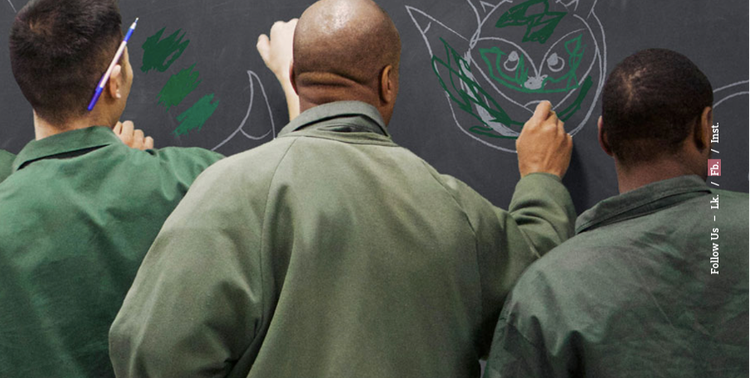Barriers to entry for creative careers can be anything from a lack of education to an inability to access tools. But what if you added a prison sentence to that list?
Getting a job on release from prison can be extremely intimidating and challenging. Alongside the stigma of a prison sentence can be poor work history, drug misuse, mental health issues, and a lack of formal education. With over 600,000 people making the transition from prison to community each year, formerly incarcerated people are unemployed at a rate (27 percent) higher than the total U.S. unemployment rate during any historical period – including the Great Depression.
Co-founders of Green Fox Training Studio, Amanda Shepherd and Kelly Willmott, are committed to the stories – and potential – behind these statistics. And their solution can be found in replacing old attitudes with new digital skills.
“I had once volunteered to teach some graphic design skills in a prison workshop,” Shepherd said. “The whole experience blew my mind. There were some incredible artists present, and they didn’t know they could get paid to use those skills. They didn’t know they could be graphic design nerds.”
The pair share two beliefs that are the guiding direction for everything they do: that everyone is born with creativity, and everyone deserves a second chance.
Built on a foundation of a long friendship and even longer careers in design and marketing, Shepherd and Willmott started social enterprise creative agency Green Fox Studio in 2018.
They set about building revenue to fund Green Fox Training Studio, Australia’s first non-profit creative agency operating a training facility inside a high-security prison, offering prisoners education in graphic design, from fundamentals all the way to real-life briefs. Since 2019, they’ve employed inmates through in-prison internships, training and working side by side with them in graphic design, desktop publishing, 3D animation and more, providing the potential for real-world employment and experience upon release within the creative industries.
“It was incredibly daunting because some of those people had never used a computer before,” Shepherd said. “But within those first few weeks, we had already ignited a passion for design amongst the inmates. It was extremely exciting because we had 30 blank canvases, and the power to change the lives of every single one of them.”
Meeting the challenge of Creativity For All
It was the physical barriers as much as the psychological ones that struck Jamie Ragen, director of solutions consulting at Adobe, the first time he visited inmates at a high-security prison.
“To get in and out, there are five levels of security,” Ragen said. “It’s not common to have computers in prison. Because these computers are air gapped – they run entirely offline – every 30 days they’re taken out for maintenance. On the way back in they are completely dismantled and reassembled by the security team.”
As part of Adobe’s commitment to enabling Creativity For All, the tools used in the graphic design classroom setting include Adobe InDesign, Illustrator, Premiere Pro and After Effects, offered on an FRL license.
According to Ragen, there’s a direct line that can be drawn between facilitating creativity and improving societal outcomes.
“The level of creativity we witness, and the way these people use our tools is unbelievable. I’m lucky enough to sit in front of the best creative minds every day, and let me tell you, the work these people produce is way up there. They're using our tools, but using them to gain skills and work has enabled them to change their lives,” he says.
According to one Green Fox trainee, one of the unique struggles of being in prison is the endless mundanity. “Trying to wrap your head around that unique nothingness of each day is just an incredible challenge. You don't realise how long every day is until you have to experience all of it while doing nothing,” they said.
The program aims to give the inmates a new way to make the most of those long days, with a way to stay purposeful and productive while incarcerated.
The transformative power of creative skills
The impact of the Green Fox Training Studio program is real and quantifiable. Since 2019, more than 160 prisoners have been trained by Green Fox Training Studio, and, for some, it’s becoming a pathway to full-time employment. In the past 12 months, only 4 percent of those people have re-offended after release, significantly less than the rate of nearly 50 percent in the wider community.
“When we started there was fear of how people would react to this, helping people get back on their feet, especially corporate organisations and governments,” Willmott said. “But people started to realise that using our services produced a really high quality of work as well as made a positive difference.”
In 2021, Green Fox Training Studio also won the Queensland Community Group of the Year award, for which they were nominated by the daughter of a Green Fox trainee – a moment that made both Willmott and Shepherd realise the impact they had not just on the inmates' lives but also on those of their families.
Word of mouth expansion means the agency has gained six employees in four years, including ex-prisoners, and the studio program is expanding into additional Australian states. Also starting in 2022 is a youth pilot program for 80 young people in community-based youth centres and a juvenile detention facility.
“You see young people in these classes who spend the whole time trying not to cry, not to show weakness,” Shepherd said. “You see people come in who just won’t talk. Some of these people have never had someone tell them they’ve done good work, and it makes them cry. There is so much time wasted in prison. You can lock a person up at 18 and they have no community engagement, no skills. If we enable skills, it really makes a difference.”




